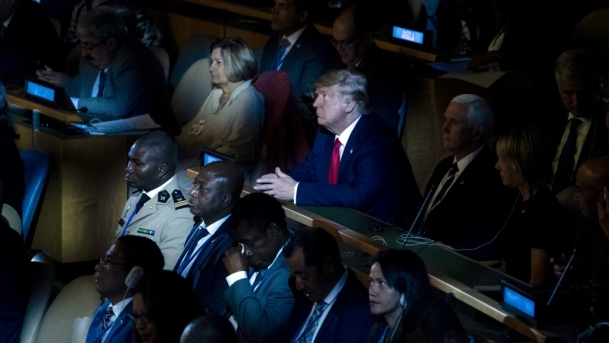
As an ironic reflection of the anti-Iran Trumpian culture in Washington, an investigative report released by the State Department inspector general’s office found that some top State Department officials, including Brian Hook, the administration’s point man on Iran, retaliated against Sahar Nowrouzzadeh, a career department official and Iran expert, in part because she is Iranian. Some internal emails in the Department described her as being among “Obama/Clinton loyalists not at all supportive of President Trump’s agenda.”(1)
This is one anecdote of how Trump’s policy toward Iran has turned into a legal battle as well as a wider debate over what Trump really has in mind to contain Tehran’s pursuit of becoming a nuclear player in the Middle East. The White House foresees the sanctions approach without military action will break the Iranian government. Some hawkish voices in Washington have urged Trump to take tough action against Iran since they believe the thesis that the lame reaction by the United States will embolden Iran “has become the conventional wisdom”; and, sooner or later, “will either openly or clandestinely seek to expand its nuclear armament program.” (2)
Iran’s president Rouhani maintains little hope in his French counterpart Macron’s mediation of the standoff between Tehran and Washington. He underscores “The American president on two occasions, once in his speech at the United Nations and another time, said explicitly that we want to intensify sanctions. I told these European friends, so which part should we accept? Should we accept your word that you say America is ready?” Rouhani also took pride in telling his cabinet “All Europeans have told me that your power today is greater than a year ago.”
In this paper, Dina Esfandiary, fellow at Harvard Kennedy School’s Belfer Center for Science and International Affairs, assesses how the current crisis between the United States and Iran unfolded, the escalation of President Trump’s policy of ‘maximum pressure’, and Iran’s response; its policy of ‘maximum resistance’. She also examines the status of tensions and whether there is any scope for resolving them, or at the very least deescalating them.
Today, the United States and Iran find themselves locked in a downward spiral of tensions following President Trump’s policy of maximum pressure and Iran’s reaction to it. Indeed, following Trump’s policy of ‘maximum pressure’, Iran elected to give the remaining states party to the deal, and Europe in particular, a year to help deliver the benefits of the deal to it. When this did not yield any results, Tehran chose to downgrade its implementation of the deal while leading or sponsoring attacks in its vicinity. The attacks are intended to raise the costs to the international community of standing by while the United States continues to increase the pressure on Iran through economic sanctions. While the desire to de-escalate exists, neither side has been able to overcome the barriers to dialogue yet. President Trump is keen to meet with his Iranian counterparts, but Iranian officials are loath to accept a mere photo opportunity. They want to be sure that meeting Trump would result in substantive dialogue to resolve tensions. Unlocking the sequencing problem may be the key to meaningful negotiations between Iran and the US.
Iran-US Tensions – Why?
President Trump made it no secret that he would have little patience with Tehran once he came to power, and that President Obama’s 2015 nuclear deal with Iran was a ‘bad deal’. (3) He did not however, immediately pull the United States out of the deal. Rather, the Trump administration chose to display its disregard and disdain for the deal during their first 18 months in power by only reluctantly recertifying the deal while discouraging Treasury from issuing licenses for exempt trade with Iran. (4) In October 2017, President Trump said this would be the last time he would certify the deal because it was their judgement that Iran had not been complying with the agreement. (5) This of course, was in direct contradiction to successive reports from the IAEA who certified Iranian compliance, (6) as did European and American intelligence assessments. (7) It came as no surprise then, when Trump pulled the United States out of the deal in May 2018. (8)
For the Iranians this presented a real problem: while they had received the sanctions relief promised by the Europeans and the UN, US sanctions - because of the reach of US financial measures - and the uncertainty surrounding what the Trump administration planned to do regarding Iran and the nuclear deal had had the effect of significantly curtailing opportunities for trade. This was key as many of the Rouhani administration’s economic plans depended on the emergence of Iran from isolation and greater ties and exchanges with other countries, especially the Europeans. But Tehran was also tired of the nuclear crisis; of the pressure, the negotiations and the nuclear issue forming the basis of all their interactions with the outside world. (9) They had endured the political cost of reaching a compromise with the West and had implemented it. They loathed to roll it back. Tehran decided to ‘wait out’ the crisis and see whether the other states party to the deal would be able to deliver on their promises.
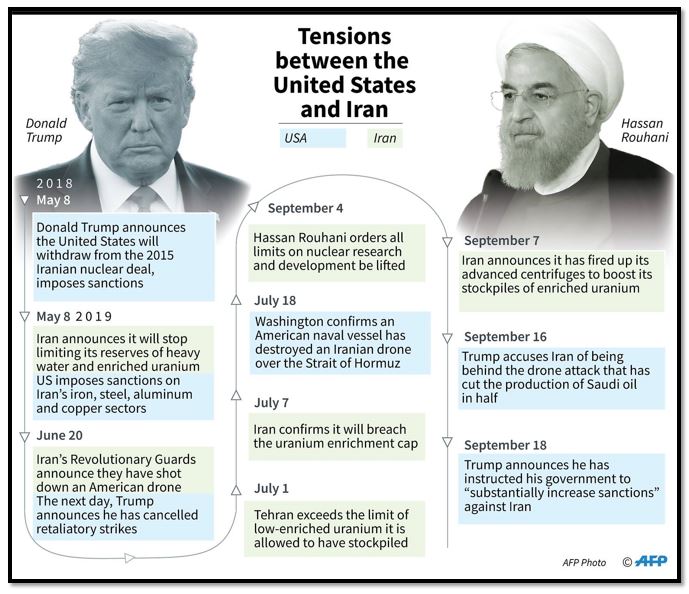 |
| Trump-Rouhani Indirect Exchanges [AFP] |
Trump’s ‘Maximum Pressure’ Campaign
On May 8, 2018, Trump announced the US would no longer be a state party to the 2015 nuclear deal. As a result, all US sanctions were re-imposed on Iran, though this did not come into effect until August 2018. The second wave of sanctions, which targeted Iran’s energy sector did not come into effect until November 2018, (10) and when they were issued, the Trump administration also issued waivers to seven countries who would continue to import Iranian oil. As a result, Iran continued its implementation of the deal, for a while.
It was almost a year later when the ‘maximum pressure’ campaign picked up in pace. On April 15, the Trump administration designated the Revolutionary Guards as a terror organisation. (11) On April 22, it cancelled remaining oil waivers, aiming to reduce Iranian oil exports to zero. (12) And in May, the administration renewed some nuclear waivers, allowing America’s allies and others to convert Iran’s nuclear facilities so they do not pose a proliferation concern, but revoked waivers allowing Iran to ship its excess heavy water abroad and swap its enriched uranium for natural uranium. (13) Combined with the inability of the remaining states party to the deal to shield Iran from these measures and assist it to receive the benefits of the deal, these developments were untenable for Tehran. As a result, the Iranians abandoned their policy of ‘strategic patience’. (14) On May 8, one year after the US announcement of withdrawal, Iranian President Rouhani announced that Iran would reduce its commitments to the deal, but it would not withdraw, for now. Highlighting Iran’s continued commitment to the deal, Rouhani stated that Iran would give remaining parties to the deal 60 days to uphold their end of the bargain, before Iran would be forced to walk away. (15)
Iranian Response
Iran was boxed in because it had few options. Tehran could not take this complaint to the United Nations Security Council, because it ran the risk of snap-back sanctions, which would be universally applied. It also did not want to simply walk away from the deal: Iran suffers from nuclear fatigue; no one wants to re-hash this issue again and most are astounded that this is where they have ended up. The Rouhani administration also did not want to risk losing international support for their continued implementation of the deal. It is noteworthy that the Islamic Republic is rarely viewed as the reasonable power, and on this, it was – most of the international community stood with Tehran against the Trump administration’s decision. The September 2018 UN Security Council meeting was proof of this, and a first for the Islamic Republic. (16) But, Tehran also could not simply sit by and continue to uphold its commitments under the deal, while the US increased its effort to punish Iran.
Iran’s initial reaction was limited and directly related to Trump’s May 2019 announcement that it would revoke two waivers allowing Iran to ship excess heavy water to Oman and trade excess enriched uranium for low enriched uranium with other countries. On May 8, President Rouhani announced that Iran would no longer ship its excess low enriched uranium and heavy water abroad, (17) and gave other states party to the deal 60 days to facilitate the promised economic dividends of the deal for Iran, after which Tehran threatened to resume enrichment beyond 3.67% and construction at Arak.
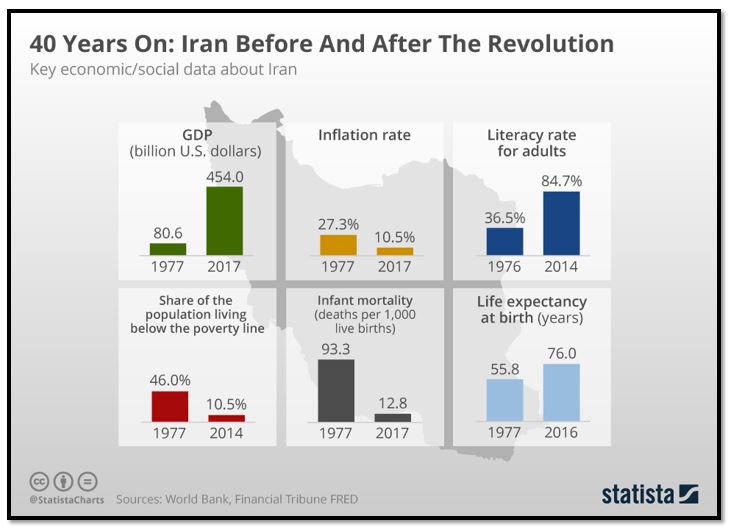 |
| Iran Over 40 Years [Statista] |
Iran’s initial measures were reversible and sat in the grey area of the Iran deal. As such, Tehran was not yet in breach of the deal. In fact, President Rouhani was at pains to highlight this in his remarks, stating that Iran was ‘diminishing its commitments’ and not withdrawing from the deal. Neither measure put Iran on the path to a nuclear weapon, but they slowly began chipping away at the constraints established by the 2015 nuclear deal – a ‘less for less’ deal as officials began to call it. Iran also outlined a general roadmap to avoid a worsening of the situation in a letter to its European counterparts, calling on the remaining five countries party to the deal to protect Iran’s interests in oil and banking sectors.
But as the Trump administration doubled down on intensifying its pressure campaign: increasing designations, including Iran’s foreign minister, (18) preventing any Iranian access to the international banking system, (19) and directly targeting Iran’s Central Bank, (20) putting whatever humanitarian channel remained at risk, (21) Iran too, increased its response.
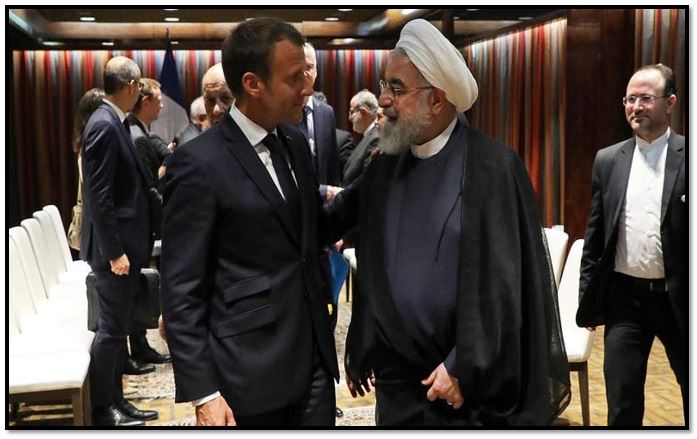 |
| Rouhani and Macon at UNGA 2019 [AP] |
In the nuclear field, on July 6, Iran announced it would take the second step in reducing its commitments to the nuclear deal. Tehran went beyond the 3.67% purity-ceiling of uranium enrichment, and once again, gave the remaining states party to the deal 60 days to react and take measures to protest Iran from worsening US sanctions. This second measure, while worrisome, was also reversible, and as such, the international community did little but caution against further steps. On September 5, Iran announced its third step: that it would no longer abide by the deal’s limits on research and development, indicating it would begin developing and using more advanced centrifuges. (22) The key element in these steps is that they are all reversible. But Iran’s ‘less-for-less’ implementation of the deal is becoming progressively more problematic and difficult to roll back as it continues. It is also becoming difficult for the other states party and the international community not to respond.
Iran in the Region
Iran’s response has not been limited to nuclear measures, in fact, these are a comparatively small part of Iran’s policy of ‘maximum resistance’. Rather, Tehran has focused its efforts on subversive activities in the region – part of its standard operating procedures.
On May 12, four commercial ships, including two Saudi oil tankers, an Emirati bunkering ship and a Norwegian oil tanker were damaged in the Gulf of Oman. The United States attributed the attack to Iran, but the Emiratis stopped short of blaming Iran for fear that it would necessarily lead to an escalation in tensions and attacks. (23) On June 13, a Japanese tanker and a Norwegian tanker were attacked near the Strait of Hurmuz, just as the Japanese Prime Minister Shinzo Abe was meeting with Supreme Leader Khamenei in Tehran. The attacks were conducted using Limpet mines and were attributed to Tehran. (24) Importantly though, the attack was not intended to lead to casualties or sink the ships, as the mines were attached to the hull of the ships. This was conducted in parallel to an increase in activity in Iraq, (25) and Yemen. Indeed, ties between the Houthis and Iran increased as the Yemen war dragged on, as did Houthi led attacks in the region. These attacks all bore the hallmarks of Iranian culpability, but without access to more information it was difficult to unequivocally pin it on Tehran.
The rise in tensions culminated in a successful September attack targeting Aramco facilities at Abqaiq and Khurais in Saudi Arabia. (26) The United States immediately blamed Iran for the attacks, (27) while Yemen’s Houthis claimed responsibility, stating they launched 10 drones into Saudi Arabia. Despite US claims, assessing responsibility without a doubt is difficult, though the sophistication and success of the attack would indicate that Iran, at the very least, had a hand in it.
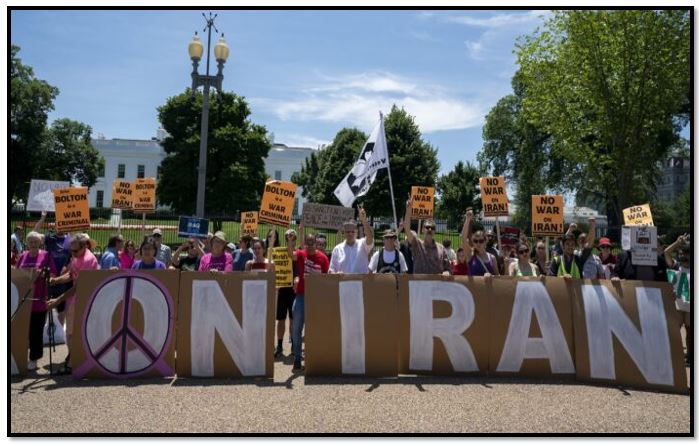 |
| Anti-war Protest in front of the White House [August 7, 2019 AP] |
These attacks were significant because they were a step up from the attacks that occurred against tankers in the Persian Gulf over the summer, directly targeting regional infrastructure. They successfully targeted a core commodity to the region, disrupted oil flow, but not excessively, and without loss of life. Indeed, the perpetrators were very aware that Saudi Arabia was not producing at full capacity, and as a result, would be able to overcome the interruption in production relatively rapidly, and despite the damage done to the facilities. The Saudi oil facilities were soft targets and a choke point in Saudi Arabia’s oil production – all Saudi crude oil production goes through its gas oil separation plant and the stabilization plants, which reduce hydrogen sulphide in the oil, at Abqaiq for processing. Iran would want to target these facilities to highlight the vulnerability of Saudi infrastructure and defence, and demonstrate its capabilities should tensions with the United States continue to escalate. The attacks could also have been intended to send a message: If Iran would not be able to sell its oil then neither would anyone else.
Is ‘Maximum Pressure’ Working?
The goals of the Trump administration’s policy are unclear. If the goal is to change Iranian behaviour, then to-date, the policy has failed: Iranian behaviour - if anything - has worsened as Tehran scrambles to not be perceived as weak, both in the region and on the nuclear front. And Iranians support it: in a poll released in October 2019, 74% of Iranians polled supported the Rouhani government’s steps reducing its implementation of the nuclear deal. (28)
If the goal is to ensure Iran returns to the negotiating table, then the more the administration doubles down on its ‘maximum pressure’ campaign and demands a submission to Pompeo’s 12 demands, (29) the less likely Iran is to agree to talks. No government wants to be seen as capitulating to another because this would set a precedent for future engagement of Iran. In addition, Iran has already agreed to dialogue with the US, provided Washington returns to the implementation of the nuclear deal first. (30) But Tehran does not want just a photo opportunity with Trump; it wants the photo to be the result of substantive dialogue, rather than its prologue.
If changing the government in Tehran is the goal, then the current wave of sanctions will not help. Squeezing the Iranian economy, preventing it from purchasing humanitarian goods and deliberately targeting specific sectors, which are big job providers, targets the Iranian public directly and paves the way for a rise in anti-American sentiment. In fact, like most other countries, the presence of a foreign enemy and his relentless efforts to squeeze Iran is uniting the usually fragmented Iranian elite, and the population with its government.
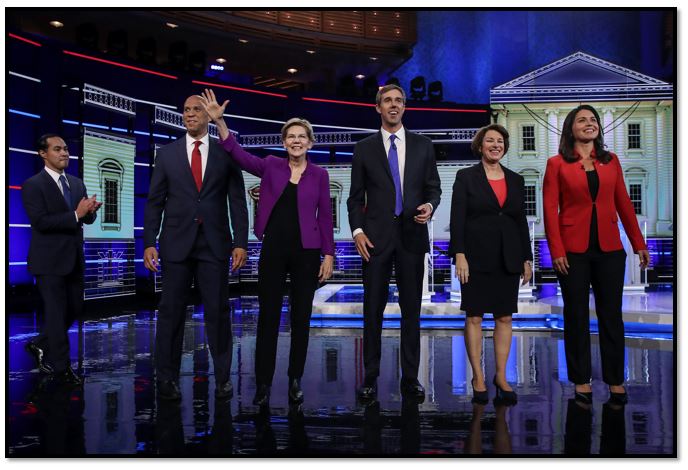 |
| Democrats candidates slam Trump's Iran policy [AP] |
What Now?
The current situation is not sustainable. Tensions have increased instability in the Middle East and markedly increased the risk of military confrontation. Iran is losing the goodwill it had garnered right after the Trump administration’s withdrawal from the deal, and Iranian actions are making it more difficult for them to maintain deniability and its influence in the region. Iran’s neighbours live in fear, knowing they would be on the front line if military confrontation broke out. The Europeans have been exposed as too weak to do much. The US is failing in its objectives to change Iranian behaviour and constrain its nuclear and missile programmes, and facing Iranian proxies throughout the region.
What can be done to diminish tensions and deter Iran? Strikes on Iranian military targets could deter it, but more likely, it would invite an Iranian response, potentially leading to all-out war in the region. The US should work with local partners in the region to develop better defences for their critical infrastructure. Most importantly, it should engage the Iranian leadership in talks to de-escalate current tensions in the region, and slowly address areas of concern. History has shown us that only dialogue will work to constrain Iran.
- Spencer Ackerman, and Erin Banco, “Probe: State Department Punished Staffer Over Iranian Heritage, Politics”, The Daily Beast, November 13, 2019 https://www.thedailybeast.com/state-dept-inspector-general-finds-brian-hook-others-retaliated-against-staffer-over-her-iranian-heritage
- Amitai Etzioni, “If Iran Gets A Nuclear Weapon, Donald Trump Is To Blame”, The National Interest, October 25, 2019 https://nationalinterest.org/blog/buzz/if-iran-gets-nuclear-weapon-donald-trump-blame-91111
- ‘Trump’s Irrational Hatred of the Iran Deal’, The New Yorker, https://www.newyorker.com/magazine/2017/10/23/trumps-irrational-hatred-of-the-iran-deal
- ‘Trump Recertifies Iran Nuclear Deal, but Only Reluctantly’, New York Times, https://www.nytimes.com/2017/07/17/us/politics/trump-iran-nuclear-deal-recertify.html
- ‘Trump Disavows Nuclear Deal, but Doesn’t Scrap It’, New York Times, https://www.nytimes.com/2017/10/13/us/politics/trump-iran-nuclear-deal.html
- ‘IAEA says Iran is complying with nuclear accord’, The Washington Post, https://www.washingtonpost.com/world/iran-adhering-to-nuclear-deal-with-world-powers-un-watchdog-says/2017/08/31/cb408e7d-bc9a-4874-bbdf-001f919a8c86_story.html
- ‘Why every other country in the Iran nuclear deal is standing by it’, Washington Post, https://www.washingtonpost.com/news/worldviews/wp/2017/10/13/european-leaders-warn-that-trump-is-wrong-on-the-iran-nuclear-deal/
- ‘Trump Pulls Out of Iran Deal’, New York Times, https://www.nytimes.com/video/us/politics/100000005890373/trump-pulls-out-of-iran-deal.html
- Author interview with Iranian officials
- ‘Iran Sanctions and Oil Prices: Who’ll Feel the Pain?’, New York Times, https://www.nytimes.com/2018/11/05/business/energy-environment/oil-prices-iran-sanctions.html
- ‘US officially designates Iran’s Revolutionary Guards as a terrorist group’, Reuters, https://www.reuters.com/article/us-usa-iran/u-s-officially-designates-irans-revolutionary-guards-a-terrorist-group-idUSKCN1RR1BE
- ‘Trump aims to drive Iran’s oil exports to zero by ending sanctions waivers’, CNBC, https://www.cnbc.com/2019/04/22/trump-expected-to-end-iran-oil-waivers-try-to-drive-exports-to-zero.html
- ‘US extends nuclear waivers for Iran, but with limits’, CNN, https://www.cnn.com/2019/05/03/politics/us-iran-nuclear-waivers/index.html
- ‘Iran sets a 60-day nuclear countdown unless Europe delivers trade’, Bloomberg, https://www.bloomberg.com/news/articles/2019-05-08/iran-submits-letter-…
- ‘UN Security Council Meeting Highlights Divisions on How to Deal with Iran’, NPR, https://www.npr.org/2018/09/26/651918747/u-n-security-council-meeting-highlights-divisions-on-how-to-deal-with-iran
- ‘US Issues New Sanctions as Iran warns it Will Step Back from Nuclear Deal’, New York Times, https://www.nytimes.com/2019/05/08/us/politics/iran-nuclear-deal.html
- ‘Treasury Designates Iran’s Foreign Minister Javad Zarif for Acting for the Supreme Leader of Iran’, US Department of Treasury Press Release, https://home.treasury.gov/news/press-releases/sm749
- ‘Trump Imposes New Sanctions on Iran, Adding to Tensions’, New York Times, https://www.nytimes.com/2019/06/24/us/politics/iran-sanctions.html
- ‘US sanctions Iran’s central bank, fund after Saudi oil attack’, Reuters, https://www.reuters.com/article/us-saudi-aramco-usa-iran/us-sanctions-irans-central-bank-fund-after-saudi-oil-attack-idUSKBN1W51Q4
- ‘Iran: Sanctions Threatening Health’, Human Rights Watch, https://www.hrw.org/news/2019/10/29/iran-sanctions-threatening-health
- ‘Iran Will No Longer Honor Nuclear Deal’s Limits on Research’, New York Times, https://www.nytimes.com/2019/09/05/world/middleeast/iran-nuclear-deal-sanctions.html
- ‘Inquiry into oil tanker attacks stops short of blaming Iran’, The Guardian, https://www.theguardian.com/world/2019/jun/07/uae-tanker-attacks-un-iran-norway-saudi-arabia
- US Navy: Mine in tanker attack bears Iran hallmarks’, AP News, https://apnews.com/5484dc4a51644fa9839546e1cd7bf89f
- ‘Iran and the United States Battle It Out in Iraq’, Foreign Policy, https://www.google.com/search?q=US+threatened+in+Iraq+after+attacks+on+Iran+militias&oq=US+threatened+in+Iraq+after+attacks+on+Iran+militias&aqs=chrome..69i57.8220j0j9&sourceid=chrome&ie=UTF-8
- ‘What we know about the attack on Saudi oil facilities’, NPR, https://www.npr.org/2019/09/19/762065119/what-we-know-about-the-attack-on-saudi-oil-facilities
- ‘US blames Iran for Saudi attacks, ‘pretend’ diplomacy’, Reuters, https://www.reuters.com/article/us-saudi-aramco-fire-pompeo/u-s-blames-iran-for-saudi-attacks-pretend-diplomacy-idUSKBN1VZ0ML
- ‘New poll: Iranians are souring on the nuclear deal and don’t want a new one’, The Bulletin of Atomic Scientists, https://thebulletin.org/2019/10/new-poll-iranians-are-souring-on-the-nuclear-deal-and-dont-want-a-new-one/
- ‘US Lays Out Demands for New Iran Deal’, Wall Street Journal, https://www.wsj.com/articles/mike-pompeo-lays-out-next-steps-on-iran-1526909126
- ‘Iran says no direct talks with Trump unless he rejoins nuclear deal’, Los Angeles Times, https://www.latimes.com/world/middleeast/la-fg-iran-trump-20180731-story.html
